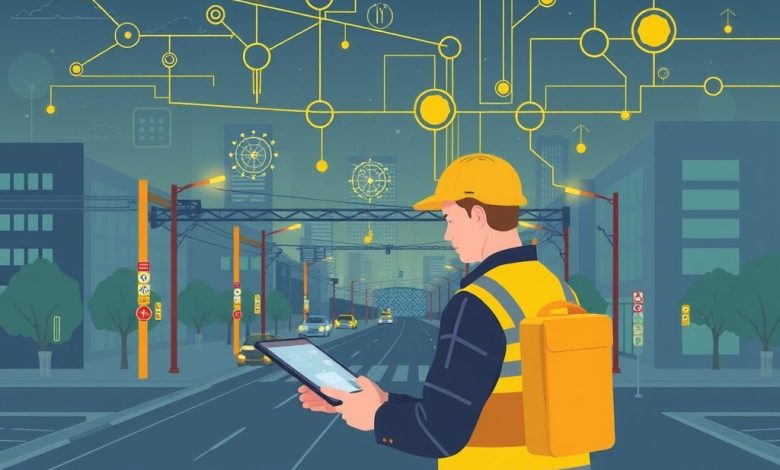Field Service Management for Smart City IoT Infrastructure

Introduction
In today’s rapidly evolving urban landscape, smart city initiatives have become increasingly prevalent. These initiatives aim to leverage technology to improve efficiency, sustainability, and quality of life for citizens. One crucial aspect of smart city infrastructure is field service management, particularly when it comes to Internet of Things (IoT) devices. This article will explore the intersection of field service management and smart city IoT infrastructure, examining its importance, challenges, and potential solutions.
- The Rise of Smart Cities and IoT
- Challenges in Field Service Management for Smart City IoT Infrastructure
- Benefits of Effective Field Service Management for Smart City IoT Infrastructure
- Key Components of Field Service Management Systems for Smart City IoT Infrastructure
- Case Study: Barcelona’s Smart City Initiative
- Conclusion
The Rise of Smart Cities and IoT
Smart cities are urban areas that integrate information and communication technology (ICT) to enhance the quality of life for citizens. This integration involves various sectors such as transportation, energy management, public safety, and infrastructure maintenance. IoT devices play a significant role in smart city initiatives, providing real-time data and enabling more efficient resource allocation.
Field service management, which involves planning, scheduling, and executing work orders for maintenance and repair services, has become increasingly important in the context of smart cities. As IoT devices proliferate across urban landscapes, the need for effective field service management becomes more critical than ever.
Challenges in Field Service Management for Smart City IoT Infrastructure
Implementing and managing field service for IoT infrastructure in smart cities presents several challenges:
- Data Overload: IoT devices generate vast amounts of data, creating information overload for field technicians.
- Real-Time Communication: Ensuring seamless communication between central systems and field workers is crucial but challenging.
- Equipment Diversity: Different types of IoT devices require specialized knowledge and equipment for maintenance and repair.
- Rapid Technological Change: The rapid evolution of IoT technology necessitates continuous training and adaptation for field staff.
- Security Concerns: Protecting sensitive data transmitted by IoT devices is paramount in urban environments.
Benefits of Effective Field Service Management for Smart City IoT Infrastructure
Despite the challenges, implementing robust field service management solutions offers numerous benefits:
- Improved Efficiency: Automated scheduling and optimized routes reduce travel time and increase productivity.
- Enhanced Customer Experience: Faster response times and more accurate issue resolution lead to higher customer satisfaction.
- Cost Reduction: Minimized downtime and reduced unnecessary visits lower operational costs.
- Data-Driven Decision Making: Access to real-time data enables better resource allocation and strategic planning.
- Scalability: Solutions designed for IoT infrastructure can adapt to growing urban populations and increasing device deployment.
Key Components of Field Service Management Systems for Smart City IoT Infrastructure
Effective field service management systems typically include the following components:
- Work Order Management: Centralized platform for creating, assigning, and tracking work orders.
- Scheduling Optimization: AI-powered algorithms to optimize route planning and technician allocation.
- Mobile Applications: User-friendly apps for field technicians to access job details and update status in real-time.
- Inventory Management: Tracking of spare parts and equipment to ensure timely availability.
- Reporting and Analytics: Dashboards and insights to monitor performance and identify areas for improvement.
- Integration Capabilities: Seamless connection with other smart city systems and IoT platforms.
- Customer Portal: Self-service options for citizens to report issues and track progress.
Case Study: Barcelona’s Smart City Initiative
Barcelona’s smart city initiative provides an excellent example of how field service management plays a crucial role in IoT infrastructure management:
- The city implemented a comprehensive smart city platform called B:SM (Barcelona Smart City).
- Field service management was integrated into the platform to manage maintenance of various IoT devices across the city.
- Technicians were equipped with mobile apps to receive and update work orders in real-time.
- AI-powered scheduling optimized routes, reducing travel time by 20% and increasing first-time fix rates by 15%.
- Citizen engagement was enhanced through a self-service portal, reducing call center inquiries by 30%.
Conclusion
Field service management is a critical component of smart city IoT infrastructure. As cities continue to embrace technology to improve urban living, the importance of efficient field service management cannot be overstated. By implementing robust solutions that address challenges such as data overload, real-time communication, equipment diversity, technological change, and security concerns, cities can maximize the benefits of their IoT investments.
The integration of field service management into smart city platforms not only improves operational efficiency but also enhances citizen satisfaction. As we move towards a more connected and intelligent urban environment, the role of field service management in managing IoT infrastructure will become increasingly vital.
By investing in cutting-edge field service management systems and staying ahead of emerging technologies, cities can ensure that their IoT infrastructure continues to serve citizens effectively and efficiently. This approach will be crucial in shaping the future of urban development and sustainability.




